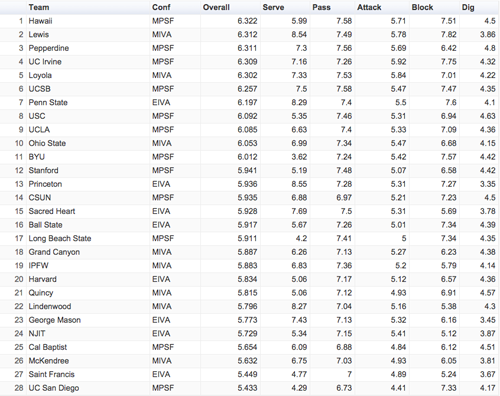[Editor’s note: Off the Block is partnering with VolleyMetrics this season to provide the volleyball community with an in-depth analysis at the stats and in-match metrics for college men’s volleyball. The following analysis is from VolleyMetrics.]
One debate that happens every year as a new season starts is about which conference is the best. As a result, we decided to start with a post about it.
Often, one conference points to the non-conference records and another conference points to the number of teams at various stages of the NCAA Tournament. This is all well and good, but there are an infinite number of ways to reason which conference is the strongest. All of these indicators have one thing in common: they are all subjective. How can we find an answer that isn’t biased or slanted? How could we be sure that it is, indeed, an efficient way to measure the strengths and weaknesses of a conference? Welcome to the wonderful world of sports statistics.
At VolleyMetrics, we wanted to be able to rate teams based on their team performance in each of the fundamental skills in volleyball: serving, passing, setting, digging, attacking and blocking. In order to do this, we needed to have a standardized rating system in place for each of these fundamentals that would make all of the ratings comparable. We created a statistically significant rating system for each fundamental except for setting that was on a 0-10 scale. With the data we currently have, it was impossible to separate setting and attacking and maintain significance in our statistical models. In the future, we hope to be able to rectify this.
Once we had a rating system for five of the fundamentals, we realized that we couldn’t just average these ratings to produce an overall ranking. Attacking had a different level of effect on the ability of a team to win a set than serving did. Because of this, we were forced to figure out the weights that standardized the effects of each rating. Essentially, if one rating had a greater effect on a team’s ability to win a set, it needed to be more greatly reflected in the model.
It should be emphasized that all of these rating were done without team identification to avoid bias in creating the models. Based on our study of the MPSF, MIVA, and EIVA, the MPSF is the strongest conference with the MIVA in second and the EIVA coming in third. It is also interesting that the difference between the first six teams is less than half the difference between the sixth and seventh place teams.


Based on our data, the MPSF is the strongest conference, but the MIVA is right behind with a difference of only 0.067 overall points. The EIVA is third by a more significant margin of 0.12 points. The table above displays how each conference did in relation to the others in each of the fundamental ratings.


 Follow
Follow
I like the article but why isn’t the Conference Carolinas not involved in this mix? It might be surprising to see if they have a say into group.